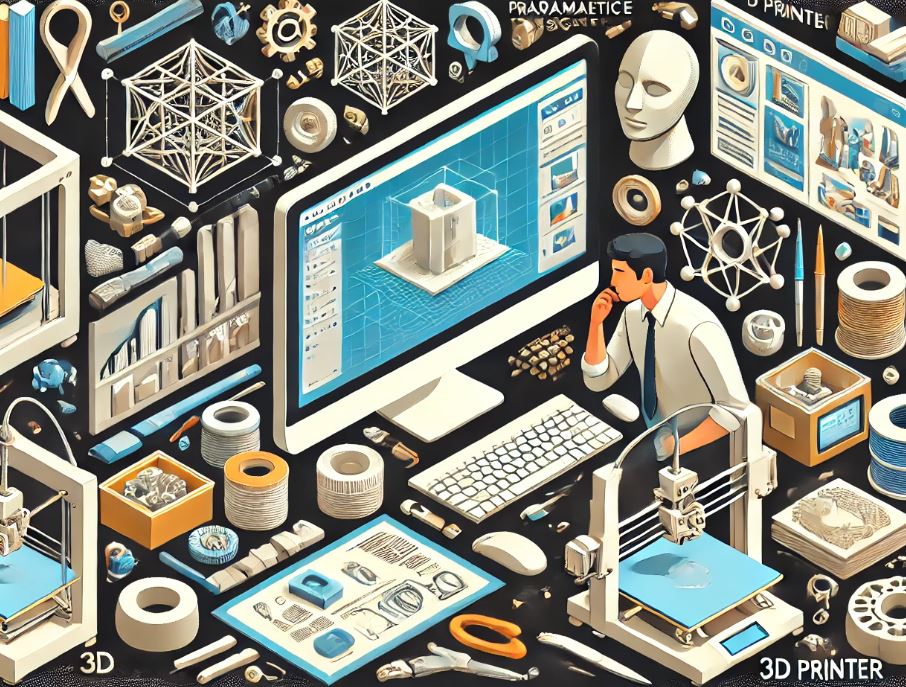I'm a participant in the Amazon Services LLC Associates Program, an affiliate advertising program designed to provide a means for me to earn fees by linking to Amazon.com and affiliated sites.
Designing 3D prints is an exciting process that transforms your ideas into tangible objects. Whether you’re a beginner or an experienced designer, understanding the fundamentals of 3D design can enhance your creativity and improve your results. This guide will walk you through the essential steps and techniques for how to design 3D prints, ensuring you get the most out of your 3D printing projects.
Make sure you have the right 3D printer as well, like the top starter 3D printers we reviewed.
Key Takeaways
- Understanding the Basics: Learn the foundational principles of 3D design to create functional and aesthetically pleasing prints.
- Using the Right Tools: Discover the best software and tools to help you design efficiently.
- Common Pitfalls: Avoid common mistakes that can affect the quality of your prints.
Getting Started with 3D Design
Understanding 3D Design Software
The first step in designing 3D prints is choosing the right software. Here are some popular options:
- Tinkercad: Ideal for beginners, Tinkercad is user-friendly and offers a wide range of basic design tools.
- Fusion 360: A more advanced option, Fusion 360 provides comprehensive features for detailed and complex designs.
- Blender: Perfect for artistic and sculptural designs, Blender is a powerful, open-source software with extensive capabilities.
Basic Design Principles
When designing for 3D printing, keep these principles in mind:
- Overhangs and Supports: Designs with overhangs greater than 45 degrees may require supports. Plan your design to minimize the need for supports.
- Wall Thickness: Ensure your walls are thick enough to provide structural integrity. A minimum of 1-2mm is recommended.
- Layer Orientation: The orientation of your design can affect its strength and appearance. Experiment with different orientations to achieve the best results.
Creating Your First Design
Start with a simple project, such as a keychain or a small box. Use the basic tools in your chosen software to create shapes, add details, and combine elements. As you become more comfortable, you can move on to more complex designs.
Advanced Design Techniques
Parametric Design
Parametric design involves using parameters to define the dimensions and features of your model. This allows for easy adjustments and precise control over your design. Software like Fusion 360 excels in parametric design, making it a valuable tool for more advanced projects.
Sculpting
For organic and artistic designs, sculpting tools are essential. Blender offers robust sculpting features that let you shape your model as if you were working with clay. This technique is ideal for creating characters, intricate details, and custom art pieces.
Prototyping and Iteration
Designing for 3D printing often involves multiple iterations. Create prototypes of your design to test its functionality and appearance. Use feedback and observations to refine and improve your model.
Recent Developments in the Field
As of July 8, 2024, there have been significant advancements in 3D design software. AI-powered tools are becoming more prevalent, offering features like automatic error detection and optimization suggestions. Additionally, cloud-based platforms are enabling collaborative design, allowing teams to work together seamlessly on complex projects.
Top Experts and Entities in the Field
Autodesk
Autodesk is a leader in 3D design software, known for its powerful tools like Fusion 360. Their continuous innovation has set industry standards and provided designers with cutting-edge solutions. Learn more about Autodesk at Autodesk.
MakeXYZ
MakeXYZ connects individuals who need 3D printing services with local makers. They have significantly contributed to the accessibility and growth of the 3D printing community. Discover more at MakeXYZ.
Formlabs
Formlabs is known for its high-quality 3D printers and materials. They also offer comprehensive resources for 3D design and printing, helping users achieve professional-grade results. Explore their offerings at Formlabs.
Internal Links
For further reading on related topics, check out these articles:
- Best 3D Printer for Beginners
- HP Smart Tank 5101 vs 5000
- Cool Things to 3D Print
- How to 3D Print a Dragon
Conclusion – How to Design 3D Prints
Designing 3D prints is a blend of creativity and technical skill. By understanding the basics, using the right tools, and staying informed about recent developments, you can create impressive and functional 3D printed objects. Embrace the learning process, experiment with different techniques, and let your imagination guide your designs.
Author: Regal Printer
Regal Printer is an expert in the 3D printing field with many years of experience. For more information and insights, visit their website.
